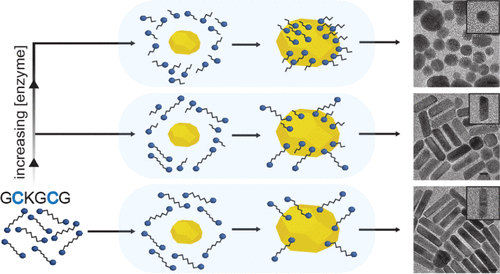当前位置:
X-MOL 学术
›
ACS Appl. Mater. Interfaces
›
论文详情
Our official English website, www.x-mol.net, welcomes your feedback! (Note: you will need to create a separate account there.)
Modulation of Gold Nanorod Growth via the Proteolysis of Dithiol Peptides for Enzymatic Biomarker Detection
ACS Applied Materials & Interfaces ( IF 9.5 ) Pub Date : 2021-09-14 , DOI: 10.1021/acsami.1c11620 Matthew N Creyer 1 , Zhicheng Jin 1 , Colman Moore 1 , Wonjun Yim 2 , Jiajing Zhou 1 , Jesse V Jokerst 1, 2, 3
ACS Applied Materials & Interfaces ( IF 9.5 ) Pub Date : 2021-09-14 , DOI: 10.1021/acsami.1c11620 Matthew N Creyer 1 , Zhicheng Jin 1 , Colman Moore 1 , Wonjun Yim 2 , Jiajing Zhou 1 , Jesse V Jokerst 1, 2, 3
Affiliation

|
Gold nanorods possess optical properties that are tunable and highly sensitive to variations in their aspect ratio (length/width). Therefore, the development of a sensing platform where the gold nanorod morphology (i.e., aspect ratio) is modulated in response to an analyte holds promise in achieving ultralow detection limits. Here, we use a dithiol peptide as an enzyme substrate during nanorod growth. The sensing mechanism is enabled by the substrate design, where the dithiol peptide contains an enzyme cleavage site in-between cysteine amino acids. When cleaved, the peptide dramatically impacts gold nanorod growth and the resulting optical properties. We demonstrate that the optical response can be correlated with enzyme concentration and achieve a 45 pM limit of detection. Furthermore, we extend this sensing platform to colorimetrically detect tumor-associated inhibitors in a biologically relevant medium. Overall, these results present a subnanomolar method to detect proteases that are critical biomarkers found in cancers, infectious diseases, and inflammatory disorders.
中文翻译:

通过二硫醇肽的蛋白水解调节金纳米棒的生长用于酶促生物标志物检测
金纳米棒具有可调节的光学特性,并且对其纵横比(长度/宽度)的变化高度敏感。因此,开发响应分析物调节金纳米棒形态(即纵横比)的传感平台有望实现超低检测限。在这里,我们在纳米棒生长过程中使用二硫醇肽作为酶底物。传感机制是通过底物设计实现的,其中二硫醇肽在半胱氨酸氨基酸之间包含一个酶切割位点。当被切割时,肽会显着影响金纳米棒的生长和由此产生的光学特性。我们证明了光学响应可以与酶浓度相关,并达到 45 pM 的检测限。此外,我们将此传感平台扩展到比色检测生物学相关介质中的肿瘤相关抑制剂。总体而言,这些结果提供了一种检测蛋白酶的亚纳摩尔方法,这些蛋白酶是在癌症、传染病和炎症性疾病中发现的关键生物标志物。
更新日期:2021-09-29
中文翻译:

通过二硫醇肽的蛋白水解调节金纳米棒的生长用于酶促生物标志物检测
金纳米棒具有可调节的光学特性,并且对其纵横比(长度/宽度)的变化高度敏感。因此,开发响应分析物调节金纳米棒形态(即纵横比)的传感平台有望实现超低检测限。在这里,我们在纳米棒生长过程中使用二硫醇肽作为酶底物。传感机制是通过底物设计实现的,其中二硫醇肽在半胱氨酸氨基酸之间包含一个酶切割位点。当被切割时,肽会显着影响金纳米棒的生长和由此产生的光学特性。我们证明了光学响应可以与酶浓度相关,并达到 45 pM 的检测限。此外,我们将此传感平台扩展到比色检测生物学相关介质中的肿瘤相关抑制剂。总体而言,这些结果提供了一种检测蛋白酶的亚纳摩尔方法,这些蛋白酶是在癌症、传染病和炎症性疾病中发现的关键生物标志物。


























 京公网安备 11010802027423号
京公网安备 11010802027423号